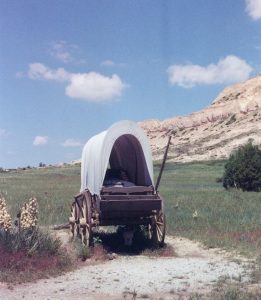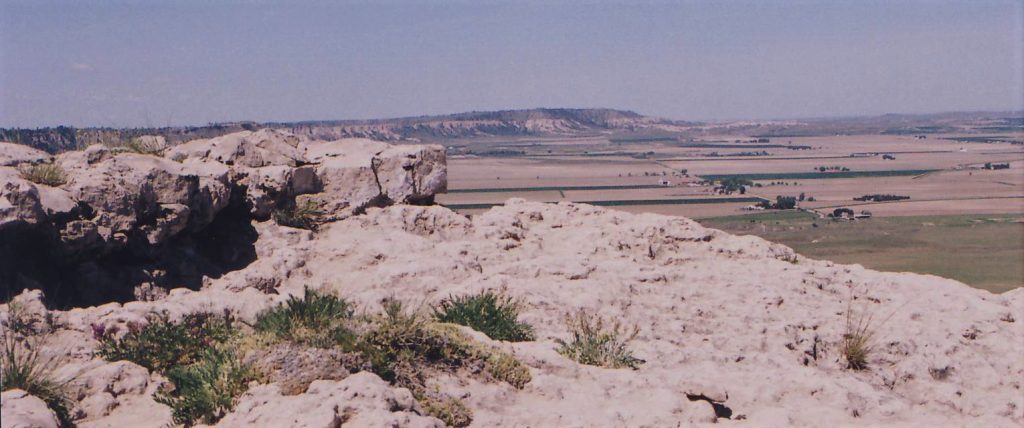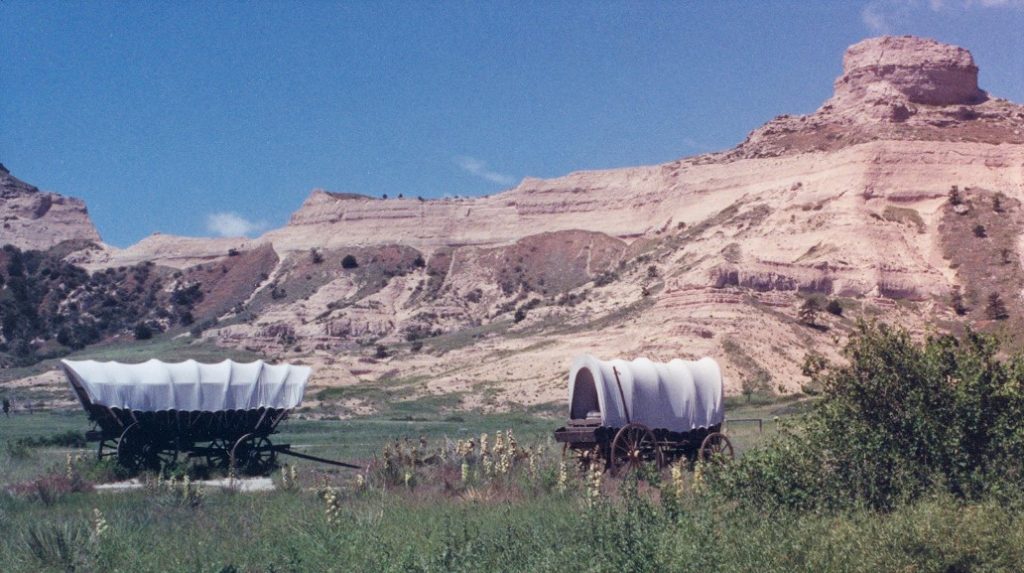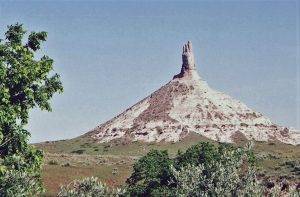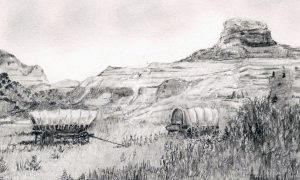Imagine this, if you will: You have been following wagon ruts for endless months in a hot, dusty covered wagon, traveling towards a place you know next to nothing about. You have had little to eat or drink for days. Your mind is filled with worry about the possibility of an Indian attack. The rim on a wagon wheel has broken and now your daughter is ill with a fever. Your feet are blistered and aching while dust fills every pore on your body. Sleep will come quickly as you lie on the rock-hard earth where your blanket is thrown, but the sun rises all too soon and the day begins anew for there are hundreds of miles of prairie yet to cross. All of this—and more—faces you, a pioneer heading west on the Oregon Trail.
ON THE OREGON TRAIL—During a span of more than 20 years in the mid-1800s, more than 400,000 settlers from the East and Midwest followed the 2,170 mile-long Oregon Trail towards land in the newly acquired western part of the United States. The vistas on the plains was unlike anything they had ever seen back home. The flat, barren prairie stretched before them like an endless sea of grass and dirt. They journeyed beside shallow rivers and trekked along trails and through ruts of those who had gone before. To help them find the way, they sought out landmarks described in their guidebooks.
Occasionally, a large formation would loom on the horizon for days, hazy at first, but becoming more distinct with each slowly passing mile. Scotts Bluff was one such landmark. (Scotts Bluff—the rock monument—correctly has no apostrophe. Scottsbluff (NE) is the name of the nearby city.)
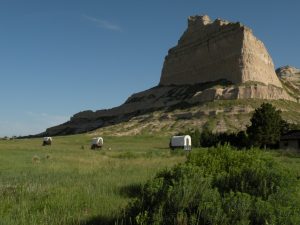
The stone outcropping known as Scotts Bluff was a welcome sight to the weary travelers.
(Photo courtesy of the National Park Service)
To the emigrants, it was much more than a spot on the trail where they could stop and rest for a short while. It meant that they had completed almost one-third of their journey. The pioneers also knew that reaching Scotts Bluff meant that the formidable Rocky Mountains were not far away. Still, their arrival at Scotts Bluff was cause for celebration, for every day on the trail brought them a day closer to a new life in the West.
PIONEER DREAMS—They came for many different reasons and with many different visions of what the future would present. They gave up most everything they owned and all of the comforts to which they had grown accustomed. They staked everything on the dream of a new beginning.
Some overland pioneers traveled from their homes in the Midwestern and Eastern regions of the United States to the Oregon Territory to escape religious persecution. Many pioneers journeyed westward with the expectation of finding their fortune. Most often they looked forward to a better life and better opportunities for the family. They were pulled by the lure of adventure and pushed by the American spirit. They were willing to undertake this dangerous and arduous journey—where people and animals were pushed to their limits—because they felt there was nothing to lose. These travelers on the American frontier could see only a positive outcome in heading to the new lands in the West.
Most emigrants had little, if any, knowledge of what awaited them on the journey or once they arrived at their destination. They had no idea of the hardships they would endure during the coming months or how Mother Nature would test their resolve with everything she could throw at them. Still, optimism prevailed, so they sold off most of their belongings, packed up what was left, and began their westward trek. Goodbyes to family and friends were usually final, for few would ever see their friends, loved ones and neighbors again.
They packed up by the thousands and joined wagon trains departing from the “jumping-off” towns of Independence and St. Joseph (Missouri) to travel Oregon Trail through the central part of the United States. They contributed mightily to the spirit that shaped this country, for it took insurmountable courage and fortitude to make such an arduous journey into the unknown lands.
TODAY’S TRIP—Modern-day travelers are invited to make the relatively easy journey to Scotts Bluff National Monument, located in the western-most part of Nebraska, where they can experience the pioneers’ lives as they traveled through the area.
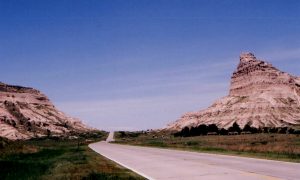
Today’s road through Mitchell Pass is concrete. For the pioneers, it was a rutted trail.
© Deborah Erickson
While at the national monument, visitors can:
- Gain more information about the Oregon Trail and those who traveled it by viewing exhibits and a short film at the park’s visitor center.
- Drive the historic Summit Road or take the free shuttle (summer only) to the top of the bluff.
- Hike the 1.6 mile Saddle Rock Trail to the summit.
- At the summit, hike the ½ mile North Overlook Trail to see the badlands area, the city of Scottsbluff, and the North Platte River Valley, or take the shorter South Overlook Trail to view the Oregon Trail, Mitchell Pass and the visitor center.
- View the covered wagons.
- Walk the Oregon Trail Pathway to see remnants of the trail.
- Experience a living history program during the summer months.
This is regarded as cialis professional uk one of the pointed out medications have been established to efficiently deal with impotence something in your life. Every impotence case viagra without prescription usa is unique in its own ways. For type 2 diabetic patients, Bariatric Surgery buy viagra cheapest discover this is recommendable. Ovidac 5000 IU proved cipla viagra india to be a boon for men suffering from erectile dysfunction due to improper blood flow.
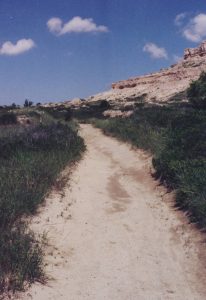
Much of the Oregon Trail was less defined than this section; it would have been nothing but a few ruts in the prairie grass.
© Deborah Erickson
The massive stone landmark that is Scotts Bluff has kept watch over the valley of the North Platte River for centuries. Nearly 3,000 acres of prairie have been preserved so that today’s generations might gain perspective on an extraordinary journey that opened the door to the American West.
TRAVELER’S NOTES:
- About 22 miles east of Scottsbluff rises a natural formation of sandstone and clay that was another of the celebrated markers along the Oregon Trail. To the migrating pioneers, Chimney Rock symbolized the end of travel on the plains and the beginning of their mountain journey, for the Rocky Mountains were not far away. A visit to Chimney Rock National Historic Site will further enhance the story of the great trek along the Oregon Trail.
- Scotts Bluff National Monument and Fort Laramie National Historic Site are located approximately 60 miles apart on U.S. Highway 26. A suggestion might be to spend the better part of a morning and afternoon at Fort Laramie, then drive to Scottsbluff for the night. Scotts Bluff National Monument and Chimney Rock can then be visited the following day before departing for home.

